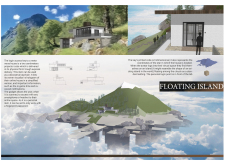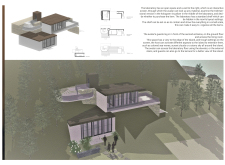5 key facts about this project
The design consists of clean lines and a contemporary aesthetic, featuring various levels that create an engaging spatial experience. Constructed predominantly with concrete, wood, glass, and metal, the materiality of the building contributes to its durability and integration with the landscape. Large glass panels provide unobstructed views and facilitate natural light, emphasizing the relationship between indoor and outdoor environments. The careful selection of materials reflects an awareness of both functionality and environmental context.
Unique Integration of Digital Technology
What distinguishes the "Floating Island" from conventional architectural designs is its integration of virtual reality elements. The project incorporates a physical cube that serves as a metaverse access tool. This device allows residents to visualize holograms of their digital space, offering direct interaction with the digital environment from within their physical home. Such functionality positions the project at the intersection of architecture and technology, allowing for seamless movement between real and virtual spheres.
Functional Design and Layout
The layout of the "Floating Island" is carefully considered to facilitate both communal interaction and private retreat. Key areas include an expansive living room that maximizes views of the surrounding mountains, as well as a laboratory space designed for exploration and experimentation with digital materials. Vertical circulation is accomplished through a combination of elevators and stairs, ensuring accessibility across all levels. The entrance is intentionally designed to welcome residents and guests, leading directly into the main living area.
In essence, the "Floating Island" project redefines modern living through its architectural approach and innovative incorporation of technology. To gain a more comprehensive understanding of this project, including detailed architectural plans and sections, it is suggested that interested readers explore the project presentation further. This will provide deeper insights into the architectural ideas and designs that inform this unique residential concept.
























